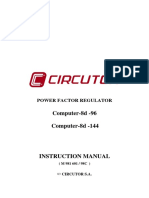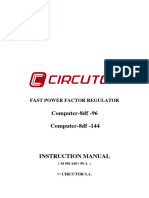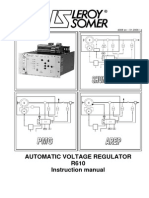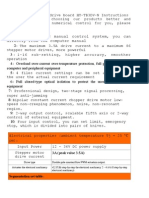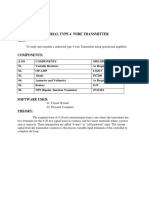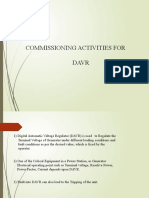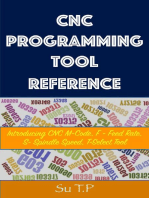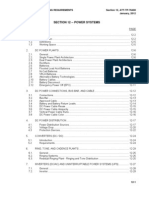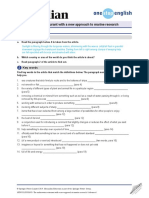Combivert F5-General / Basic Hardware
Combivert F5-General / Basic Hardware
Uploaded by
Vijaya KumarCopyright:
Available Formats
Combivert F5-General / Basic Hardware
Combivert F5-General / Basic Hardware
Uploaded by
Vijaya KumarOriginal Description:
Original Title
Copyright
Available Formats
Share this document
Did you find this document useful?
Is this content inappropriate?
Copyright:
Available Formats
Combivert F5-General / Basic Hardware
Combivert F5-General / Basic Hardware
Uploaded by
Vijaya KumarCopyright:
Available Formats
1
COMBIVERT
F5-GENERAL / BASIC
Hardware
2
Static frequency
inverters 0,37 ... 355 KW
0,37 ... 2,2 KW - 200 V
0,37 ... 30 KW - 400 V
0,37 ... 45 KW - 200 V
0,37 ... 355 KW - 400 V
the open loop drives
0,37 ... 45 KW - 200 V
0,37 ... 90 KW - 400 V
3
Technical Data
4
Error detection
E.LSF
E.OP
E.UP
E.OC
E.OL
E.OH E.dOH
5
Voltage level F5
230 V- device:
E.UP (POFF): U
dc
= 180 V
E.UP: U
dc
= 216 V
idling: U
dc
= 325 V
GTR 7: U
dc
= 380 V
E.OP: U
dc
= 400 V
400 V- device:
E.UP (POFF): U
dc
= 200 V
E.UP: U
dc
= 240 V
idling: U
dc
= 565 V
GTR 7: U
dc
= 740 V
E.OP: U
dc
= 800 V
6
Overload
Characteristic
7
Terminal Strip
Power Part
8
Protective Functions
Motor protection with NC-contact:
This function is deactivated in Pn.12 /
CP.28 in the factory setting of the open
loop devices (F5.G/B).
Therefore after connecting the motor
sensor to terminals T1 / T2 the
function must be activated in Pn.12 /
CP.28.
T1/T2 jumper is not necessary in delivery state !
9
Breaking resistor PTC
connection
Protection against GTR7 damage!
In case of overheating the resistor the disconnection of the power supply avoids a
permanent braking current.
10
Analog Signals
Terminal strip F5-C / G / M
11
Digital Signals
Terminal strip F5-C / G / M
12
Relay Outputs
Terminal strip F5-C / G / M
13
Terminal strip F5-B
14
COMBIVERT
F5-GENERAL / BASIC
Parameter handling
15
Start-up
Three conditions must be fullfilled to start up the inverter:
Control release
Direction of rotation
Frequency (or speed) set value
The control release has to be activated by hardware (terminal 16).
The direction of rotation (in factory setting by terminal F/R) can also be
selected by parameter value (digital) or by the sign of the frequency set value.
The set value (in factory setting by analog input 1) can also be selected by
parameter value (digital).
16
COMBIVIS
the programming and diagnosis tool
free available software for
- project organisation
- drive adjustments
- upload / download / storage
- PC scope
Including unique service concept for field bus connection
via HSP5 - port
( display of parameters and values )
17
CP-parameters
Features of customer-oriented parameters
Clarity: All important functions are summarized in one menu.
Flexibility: The assignment of the CP-parameters can be changed
according to your application (max. 36 parameters).
Easy handling: Parameter values can be changed simply by
double-clicking the parameter (COMBIVIS).
Protection: Critical parameters of the application interface are
protected against maloperation.
18
CP-parameters
19
CP-parameters
(continuation)
20
Definition of
CP-parameters
Example: CP.35 shall represent the switching frequency in the sets 0, 2, 4 and 6;
CP.36 shall represent the switching frequency in the remaining sets.
Solution: Switching frequency = Par. uF.11; address 050Bh
ud.15 = 35; ud.16 = 050Bh, ud.17 = S.0,2,4,6, direct set selection, standardization
ud.15 = 36; ud.16 = 050Bh, ud.17 = S.1,3,5,7, direct set selection, standardization
21
For these sets the CP-parameter shall
be valid.
Selection:
CP-par. valid for above listed
sets
CP-par. valid for actual set
CP-par. valid for set selected by
setpointer Fr.09
Select standardization:
Standard (no user
standardization)
Standardization from set 1-7
Example for standardization
of a CP-parameter
22
Example for standardization
of a CP-parameter
For a motor (4-poles, n = 1410 rpm) with gearbox (i = 7.05) the output
speed shall be displayed in CP3. Since no motor feedback is available,
the actual frequency must be converted accordingly.
Furthermore it is important to know that the resolution of the freq. is
1/80 Hz. That means: 1 Hz has an internal value of 80.
At 50 Hz the speed at the motor shaft is 1410 rpm / 7,05 = 200 rpm
50 Hz without standardization is internal 50*80 = X = 4000
To get the gear output speed of 200 rpm (50 Hz) a division by 20 is
required (200 = 4000 / 20).
23
Example for standardization
of a CP-parameter
Suitable parameterlist:
I ud15 cp selector 3 (Pointer for CP3)
I ud16 cp address 0203h
I ud17 cp set norm S0+direct (bit 0-7)+display norm set 2
2 ud18 Divisor Norm 20
2 ud19 Multiplic. Norm 1
2 ud20 Offset Norm 0
2 ud21 ctrl. Disp. Norm 1/min+standard calcul.+no dec.places
24
Resetting of parameters to factory setting (load default values)
Parameter initialization
0. F r. 0. 0
d E F
i n i t
Important:
Open control
release!
Loading of default
values into one set
Loading of default
values into all sets
P A S S
P A S S
25
Parameter structure
in the application mode
The application parameters are split into 19 groups.
There are 8 such groups, i.e. 8 parameter sets exist.
Set 0 Set 1 Set 2 Set 3 Set 4 Set 5 Set 6 Set 7
ru-Par.
op-Par.
pn-Par.
uf-Par.
dr-Par.
cn-Par.
ud-Par.
fr-Par.
an-Par.
di-Par.
do-Par.
.
.
.
.
.
ru-Par.
op-Par.
pn-Par.
uf-Par.
dr-Par.
cn-Par.
ud-Par.
fr-Par.
an-Par.
di-Par.
do-Par.
.
.
.
.
.
ru-Par.
op-Par.
pn-Par.
uf-Par.
dr-Par.
cn-Par.
ud-Par.
fr-Par.
an-Par.
di-Par.
do-Par.
.
.
.
.
.
ru-Par.
op-Par.
pn-Par.
uf-Par.
dr-Par.
cn-Par.
ud-Par.
fr-Par.
an-Par.
di-Par.
do-Par.
.
.
.
.
.
ru-Par.
op-Par.
pn-Par.
uf-Par.
dr-Par.
cn-Par.
ud-Par.
fr-Par.
an-Par.
di-Par.
do-Par.
.
.
.
.
.
ru-Par.
op-Par.
pn-Par.
uf-Par.
dr-Par.
cn-Par.
ud-Par.
fr-Par.
an-Par.
di-Par.
do-Par.
.
.
.
.
.
ru-Par.
op-Par.
pn-Par.
uf-Par.
dr-Par.
cn-Par.
ud-Par.
fr-Par.
an-Par.
di-Par.
do-Par.
.
.
.
.
.
ru-Par.
op-Par.
pn-Par.
uf-Par.
dr-Par.
cn-Par.
ud-Par.
fr-Par.
an-Par.
di-Par.
do-Par.
.
.
.
.
.
26
Direct set addressing
27
Operating modes
Setpoint selection
28
Operating modes
Selection of the direction of rotation
29
Protective functions
For the following errors or warnings different reactions can be defined.
Warning means, that an adjusted level has been reached, e.g. OH=65C,
but the case of a fault (usually OH=90C) has not yet occurred.
External error (E.EF, response in Pn.3)
OH warning, temperature power modules (level in Pn.11, response in Pn.10)
OL warning, overload (level in Pn.9, response in Pn.8)
Bus error (E.bus, response in Pn.5)
dOH Warning, -> temp. sensor at T1, T2 (time until switch off Pn.13,
immediate response Pn.12)
30
Possible reactions on errors
and warnings
31
Several switching conditions can be set for the case of warnings
(independent from the reaction.)
Protective functions
32
Error Counters,
Error Diagnosis
In.25: the last eight errors with
the time difference in min
between the same error type
In.26-30: error counters for the
main error types
33
Voltage stabilization
34
COMBIVERT F5
Sensorless Motor
Management (SMM)
35
more breakdown torque at small speeds
reduced current consumption and motor heating at idle running
speed stability under load
faster reaction at torque jumps
improved behaviour in generatoric operation
Decisive advantages:
F5: Sensorless Motor
Management (SMM)
The sensorless speed control (Open Loop Vector Control)
36
Magnetizing (idling) current control
Sensorless Motor
Management (SMM)
The sensorless speed control (Open Loop Vector Control)
consists of the following 3 functions:
Active current (torque) control; I x R-compensation
Load dependent frequency change (slip compensation)
37
Sensorless Motor
Management (SMM)
1) Identify and enter motor data (dr.0...dr.6)
Type plate data
Stator resistance (measure by ohmmeter or directly by inverter (-> dr.6))
(Attention! The measurement by dr.6 should take place at uf.11=2 kHz for max. accuracy)
3) If possible run motor without load at rated frequency and measure current (ru.15)
Steps of commissioning (starting from the factory setting)
2) Pre-adjustment of the U/f-characteristic
rated frequency (uf.0) = rated freq. of the motor, (consider wiring of the motor!)
adjust boost (uf.1) = 0% at first
adjust voltage stabilization (uf.9) = rated motor voltage
adjust the parabolic characteristic (uf.2 = -1)
4) Enable magnetizing current control (uf. 17 = 0.0; uf.16 = 1)
5) If the idling current (ru.15) significantly increases at low frequencies:
enable energy saving mode (uf.6 =1 )
calibrate the energy saving factor uf.7 so that you get the same idling current at low
frequencies (compare with point 3))
38
Sensorless Motor
Management (SMM)
6) Adjust boost (uF.1) so that the idling current of point 5) just doesnt increase
(Boost serves as a pre-control for the magnetizing current controller)
8) Adjust autoboost-amplification
adjust amplification uF.17 so that the current (ru.15) and voltage (ru.20) dont oscillate
(factory setting: uf.17 = 1,2)
9) Enable slip compensation
CS.0 = 2; the other bits are without function here
determine the max. frequency increasing f (CS.4); e.g. 5...10 Hz
if necessary optimize dynamic behaviour with CS.9 (and CS.6)
10) Check at idle running and with load
set frequency (ru.2), actual frequency (ru.3) and motor speed
apparent current (ru.15) and active current (ru.17)
output voltage (ru.20)
Steps of commissioning
7) Check the active current (ru.17) at idle running at low frequencies; if necessary
adapt the stator resistance (dr.6) so that ru.17 is as close as possible near to zero
39
Sensorless Motor
Management (SMM)
1) Identify and enter motor data (dr.0...dr.6)
Type plate data
Stator resistance (measure by ohmmeter or directly by inverter (-> dr.6))
(Attention! The measurement by dr.6 should take place at uf.11=2 kHz for max. accuracy)
Alternative: Fast start-up
3) Check at idle running and with load
set frequency (ru.2), actual frequency (ru.3) and motor speed
apparent current (ru.15) and active current (ru.17)
output voltage (ru.20)
2) Open control release and adjust Fr.10 = 3
This procedure automatically loads the following parameters:
rated freq. (uf.0) = rated freq. of the motor (Attention: for 87Hz-operation adjust uf.0 manually!)
voltage stabilisation (uf.9) = rated motor voltage
boost (uf.1) suitable for the motor data
parabolic U/f-characteristic (uf.2=-1)
autoboost-activation (uf.16=1)
autoboost gain factor (uf.17=1.2)
slip compensation activation (CS.0 and CS.1)
slip compensation limitation (CS.4) suitable for the motor data
slip compensation controller pre-adjustment (CS.6 and CS.9)
40
Sensorless Motor
Management (SMM)
to increase the torque at low setpoints:
increase the autoboost amplification uF.17
increase the magnetizing current (-> uf.7)
if necessary reduce stator resistance (dr.6) a little bit
Practical hints for optimization and elimination of problems
in case of high current consumption during idle running or part load operation
reduce magnetizing current (-> uf.7)
if necessary increase stator resistance (dr.6) a little bit
in case of over-compensation (motor runs too fast):
increase stator resistance (dr.6) a little bit, so that the active current ru.17 is approx.
zero during idling
if necessary increase the rated speed of the motor (dr.1) a little bit
in case of current oscillations at special speed ranges:
reduce autoboost amplification uF.17
reduce magnetizing current (-> uf.7)
if necessary optimize the boost (uf.1) (-> see commissioning step 6)
optimize ID-correction (F5-G: AA.21-24, F5-B: xy.21-24; only possible with superv. password)
reduce kP and kI of the magnetizing current controller (F5-G: AA.14/15, F5-B: xy.1/2; only
possible with supervisor password)
41
To get a good control behaviour its necessary to determine the rotor resistance
(parameter dr.6) as accurate as possible. The resistance is perfectly adjusted when
the active current (ru.17) shows 0 at idling motor.
Method 1: Run motor at idling and adjust rotor resistance (dr.6) until the active current (ru.17)
becomes zero.
Determination of the rotor resistance
Method 2: Measure rotor resistance directly between 2 output terminals of the inverter (U,V,W)
and enter the result into dr.6.
Method 3: Activate automatic calibration of the inverter (Calculate Drive Data). Therefore
adjust uf.11=2kHz and bring inverter into status LS (activate control release but no
direction of rotation) and enter the value 50 or 5000 into dr.6. The inverter now measures
all 3 motor phases one after the other with the rated motor current (dr.0) and enters the
average value of the resistance into dr.6.
Attention! If the adjusted resistance dr.6 is too small (=> active current ru.17 at idling
> 0), this leads to over-compensation, i.e. the motor runs too fast.
If the adjusted resistance dr.6 is too big (=> active current ru.17 at idling < 0), the motor
runs too slowly or it doesnt start at all on small setpoints. In addition the max. torque at
small speeds is reduced.
F5: Sensorless Motor
Management (SMM)
42
COMBIVIS 5 Scope - Umrichter 1
COMBIVIS 5 Version 5.25 Registriert f r: Entwicklung KEB Barntrup
Druckdatum: 06.06.01 13:27:46
503: F5-G/V2.10 400Hz (B)
X (ms/Teilung): 500
CH Parameter Satz Y-Faktor (n/Teilung) Y-Null bei
A ru03 actual f requency display 0 2,0000 Hz 0,0000 Hz
B ru15 apparent current 0 1,0 A 0,0 A
C ru20 output voltage 0 10 V 50 V
D Aus
AB
C
Cursor I:7295ms (06.06.2001 13:23:22) Cursor II:9451ms (06.06.2001 13:23:24) Dif f erenz:2156ms
ru03 0,0000 Hz[0] 0,0000 Hz[0] 0,0000 Hz[0]
ru15 2,8 A[28] 2,8 A[28] 0,0 A[0]
ru20 25 V[25] 25 V[25] 0 V[0]
I
U
Phase U Phase V Phase W
Autom. measurement of the rotor resistance (Calculate Drive Data)
Attention: If the error E.Cdd appears during the measurement of the rotor resistance,
the resistance of the phases is either strongly unsymmetric or - especially at a small
motor power and an oversized inverter - too high for the check routine. In these cases it
should be determined by method 1 or 2.
F5: Sensorless Motor
Management (SMM)
43
red: act. freq. (2Hz / DIV); blue: motor current (1A / DIV); green: output voltage (10V / DIV)
SMM disabled; 12% boost
necessary for sufficient torque
(therefore very high current at idling (saturation))
SMM active; 0% boost
(low current at idling)
Load change from idling to rated torque at 4 Hz
Asynchronous motor 0,55 kW, 4-pole; Inverter 0,75 kW
idling idling Tn idling idling Tn
F5: Sensorless Motor
Management (SMM)
44
Behaviour motoric / generatoric at 4 Hz
Asynchronous motor 0,55 kW, 4-pole; Inverter 0,75 kW
idle Tn mot. idle Tn gen.
n
T
idle
SMM disabled; 12% boost
necessary for sufficient torque
SMM active;
0% boost; uF.16=3
F5: Sensorless Motor
Management (SMM)
idle Tn mot. idle idle Tn gen.
n
T
45
SMM disabled; 12% boost
necessary for sufficient torque
SMM active;
0% boost; uF.16=3
Behaviour motoric / generatoric at 4 Hz
Asynchronous motor 0,55 kW, 4-pole; Inverter 0,75 kW
idle Tn motoric idle idle Tn generat.
f
I
U
idle Tn motoric idle idle Tn generat.
f
I
U
F5: Sensorless Motor
Management (SMM)
46
F5 without SMM F5 with SMM
100 ms 100 ms
F5: Sensorless Motor
Management (SMM)
red: actual speed (50 min
-1
/ DIV);
blue: torque (2 Nm / DIV)
Torque jump from idling to rated torque at 1000 min
-1
Asynchronous motor 0.55 kW, 4-poles; Inverter 0.75 kW
47
COMBIVIS 5 Scope - C:\KebData\COMBIVIS5\smm-I-Anteil.sc5 - Umrichter 1
COMBIVIS 5 Version 5.25 Registriert f r: Entwicklung KEB Barntrup
Druckdatum: 05.06.01 10:35:25 Dateidatum: 30.05.01 08:30:30
0,55 kW-Motor, 07.F5-G
2 Hz; Lastsprung auf 150 % Nennmoment; P-Anteil (CS.6) = 0
a) CS.9 = 100
b) CS.9 = 500
c) CS.9 = 2500
1088: F5-G/V2.00 400Hz (B)
X (ms/Teilung): 5000
CH Parameter Satz Y-Faktor (n/Teilung) Y-Null bei
A ru03 Istf requenz-Anzeige 0 2,0000 Hz 0,0000 Hz
B ru20 Ausgangsspannung 0 10 V 50 V
C ru15 Scheinstrom 0 1,0 A 5,0 A
D Aus
A
B
C
f
U
I
CS.9 = 100 CS.9 = 500 CS.9 = 2500
F5: Sensorless Motor
Management (SMM)
Torque jump to 150% T
n
at 2 Hz with different adjustments of CS.9
48
F5: Sensorless Motor
Management (SMM)
F5: Sensorless Motor Management
0,55 kW-motor, 0,75 kW-inverter
0
1
2
3
4
5
6
7
8
9
10
0 1 2 3 4 5 6 7 8 9 10
fset in Hz
T
m
a
x
i
n
N
m
rated motor torque = 3,7 Nm
hardware current limit reached
F5 with SMM
F4 with slip comp. and autoboost
F5 without SMM
You might also like
- 175-4998 Signal Converter - CaterpillarDocument5 pages175-4998 Signal Converter - CaterpillarImad Hmd75% (4)
- RPM 8 ManualDocument37 pagesRPM 8 Manualshaik kaleesha vali73% (56)
- 8d-14d PFC Controller Manual PDFDocument29 pages8d-14d PFC Controller Manual PDFSergio100% (1)
- Fuji Starting Guide G11S-LE2 - Lift - 7Document54 pagesFuji Starting Guide G11S-LE2 - Lift - 7Nguyen Anh Tu100% (3)
- A Practical Guide To Safely Installing Electrical Wiring in Your HomeDocument21 pagesA Practical Guide To Safely Installing Electrical Wiring in Your HomeFaeze WaeziNo ratings yet
- Maori Planning TemplateDocument4 pagesMaori Planning Templateapi-282689395100% (1)
- POF Specs 2009Document38 pagesPOF Specs 2009eRCeckoNo ratings yet
- Receptor Satélite Fortecstar Lifetime UltraDocument28 pagesReceptor Satélite Fortecstar Lifetime UltraHugo Roberto RibeiroNo ratings yet
- ATV12 Communication Parameters BBV51917 1.4IE05bDocument12 pagesATV12 Communication Parameters BBV51917 1.4IE05bRicardo Rodriguez ParedesNo ratings yet
- Digital Automatic Voltage RegulatorDocument2 pagesDigital Automatic Voltage RegulatorPedro BancayanNo ratings yet
- Computer 8df enDocument29 pagesComputer 8df enaquistapace8073No ratings yet
- UHU Servo Controller 300 enDocument13 pagesUHU Servo Controller 300 enZoltán NémetNo ratings yet
- Program Controller For RCA2/RCA: List of ModelsDocument10 pagesProgram Controller For RCA2/RCA: List of ModelsElectromateNo ratings yet
- Manual Motores Do Ferro Velho SanyoDocument64 pagesManual Motores Do Ferro Velho SanyoanclamixNo ratings yet
- I-Monitor Motor Controller Manual Rev 7 6Document72 pagesI-Monitor Motor Controller Manual Rev 7 6elch310scridbNo ratings yet
- Ls Inverter Ic5Document20 pagesLs Inverter Ic5lamonahNo ratings yet
- Feature General Description: HT7A6005 Low Power, Wide Temperature Range General Purpose Current Mode PWM ControllerDocument11 pagesFeature General Description: HT7A6005 Low Power, Wide Temperature Range General Purpose Current Mode PWM ControllerEnéas BaroneNo ratings yet
- 87 Catalog Invertere Ic5Document19 pages87 Catalog Invertere Ic5vga1234No ratings yet
- TB233 (Rev1) - Fanuc Yellow Cap Motor/Velocity Control Drive Setup For CNC11 SystemsDocument5 pagesTB233 (Rev1) - Fanuc Yellow Cap Motor/Velocity Control Drive Setup For CNC11 SystemsRudolf OppermannNo ratings yet
- Program Controller For RCP3/RCP2 Series: List of ModelsDocument10 pagesProgram Controller For RCP3/RCP2 Series: List of ModelsElectromateNo ratings yet
- Ic5 CatDocument20 pagesIc5 CatKỹ Sư TđhNo ratings yet
- Tài Liệu Biến Tần LS IC5Document20 pagesTài Liệu Biến Tần LS IC5hieudaivuongNo ratings yet
- IC5 Catalogue 2013.10 ENGDocument20 pagesIC5 Catalogue 2013.10 ENGKurnia FajarNo ratings yet
- VSD Pid ControlDocument8 pagesVSD Pid ControlSupriyo SajaNo ratings yet
- Motor Identification Simovert Masterdrives VCDocument4 pagesMotor Identification Simovert Masterdrives VCFelipe Polix BarbosaNo ratings yet
- AC Drive BasicsDocument6 pagesAC Drive Basicschiraga2001No ratings yet
- 4008a en PDFDocument45 pages4008a en PDFHamsuddin TeknikNo ratings yet
- BHSS 750w Step Servo PDFDocument20 pagesBHSS 750w Step Servo PDFDeepak RainaNo ratings yet
- HY-TB3DV-N 3 Axis Driver Board Manual PDFDocument12 pagesHY-TB3DV-N 3 Axis Driver Board Manual PDFjoelgcrNo ratings yet
- Compacte Handleiding V7Document60 pagesCompacte Handleiding V7gui9871No ratings yet
- Mitsubishi v500 VFD Brochure UpdatedDocument12 pagesMitsubishi v500 VFD Brochure UpdatedMROstop.comNo ratings yet
- User Manual 5 Axis Breakout BoardDocument10 pagesUser Manual 5 Axis Breakout BoardDavid FernandezNo ratings yet
- FAQ 6RA70 Fault Diagnostics enDocument81 pagesFAQ 6RA70 Fault Diagnostics enKsmah Mah100% (1)
- 5 Allocation of Buffer Memories (BFM) 3 Installation and WiringDocument8 pages5 Allocation of Buffer Memories (BFM) 3 Installation and WiringArvind KumarNo ratings yet
- PCC Commissioning Guide LinesDocument21 pagesPCC Commissioning Guide LinesSyed Mohammad Naveed100% (7)
- Exp-7 3-Ph Vsi Fed PWM InvDocument5 pagesExp-7 3-Ph Vsi Fed PWM Invaman srivastavaNo ratings yet
- NPM Motion Control Serial Communication CatalogDocument24 pagesNPM Motion Control Serial Communication CatalogElectromateNo ratings yet
- Drive Systems A500 Series: Your Partner in Industrial Automation SystemsDocument4 pagesDrive Systems A500 Series: Your Partner in Industrial Automation SystemsFranklin DannyNo ratings yet
- Changzhou Wantai Electrical Appliance Co., LTD: User Guide For 4 Axis TB6560 Driver BoardDocument11 pagesChangzhou Wantai Electrical Appliance Co., LTD: User Guide For 4 Axis TB6560 Driver BoardP BNo ratings yet
- RFQ No. ASPA17.030 Supply & Delivery of VFDs For The Tafuna WWTP-Attachment B - VFD SpecificationDocument6 pagesRFQ No. ASPA17.030 Supply & Delivery of VFDs For The Tafuna WWTP-Attachment B - VFD SpecificationPRABHU SHANKAR MNo ratings yet
- Manual BTC4300Document142 pagesManual BTC4300Adrian VintilaNo ratings yet
- Ci Driver Do Motor Do CD Rom DatasheetDocument11 pagesCi Driver Do Motor Do CD Rom DatasheetAdriano TameouvindoNo ratings yet
- Designing Amplifiers With Tripath'S High-Power Class-T DriversDocument9 pagesDesigning Amplifiers With Tripath'S High-Power Class-T Driversprasad357No ratings yet
- CDP 1802 Data Sheet 2Document7 pagesCDP 1802 Data Sheet 2DaveNo ratings yet
- Flow Indicating Transmitter KOBOLD MANUAL PDFDocument12 pagesFlow Indicating Transmitter KOBOLD MANUAL PDFOmar BouamoudNo ratings yet
- Digital Sensor: SupplyDocument6 pagesDigital Sensor: SupplyYUDI WAHYUDI 17249No ratings yet
- Tc-2060 Instruction Manual v0.09Document93 pagesTc-2060 Instruction Manual v0.09Herry SusiloNo ratings yet
- Technical Feedback EhtcDocument9 pagesTechnical Feedback EhtcPrashant Kumar ChoudharyNo ratings yet
- Read MeDocument14 pagesRead MeJaga deshNo ratings yet
- UHU Servo Controller 300 enDocument13 pagesUHU Servo Controller 300 enderbalijalelNo ratings yet
- High-Performance Ee PLD ATF16V8C: FeaturesDocument18 pagesHigh-Performance Ee PLD ATF16V8C: FeaturesAmol LandgeNo ratings yet
- Slvsbt3b Three-Phase Brushless Motor DriverDocument38 pagesSlvsbt3b Three-Phase Brushless Motor Driverphamvan_tuongNo ratings yet
- Description Power Range: Analog Servo DriveDocument9 pagesDescription Power Range: Analog Servo DriveElectromateNo ratings yet
- MP 4000Document3 pagesMP 4000VikrantNo ratings yet
- ACS 800 Hack, g9 Mali TransportDocument3 pagesACS 800 Hack, g9 Mali Transportsasa83% (6)
- FDD Spindle Motor DriverDocument11 pagesFDD Spindle Motor DrivercostpopNo ratings yet
- Commissioning of DAVRDocument70 pagesCommissioning of DAVRPMG Bhuswal Project100% (1)
- ATV21 HVAC ShortformV2.1Document4 pagesATV21 HVAC ShortformV2.1Syed Noman AhmedNo ratings yet
- Reference Guide To Useful Electronic Circuits And Circuit Design Techniques - Part 2From EverandReference Guide To Useful Electronic Circuits And Circuit Design Techniques - Part 2No ratings yet
- Reference Guide To Useful Electronic Circuits And Circuit Design Techniques - Part 1From EverandReference Guide To Useful Electronic Circuits And Circuit Design Techniques - Part 1Rating: 2.5 out of 5 stars2.5/5 (3)
- Analog Dialogue, Volume 48, Number 1: Analog Dialogue, #13From EverandAnalog Dialogue, Volume 48, Number 1: Analog Dialogue, #13Rating: 4 out of 5 stars4/5 (1)
- Orbital Riveting Technology: Ecoline En/Ene 20 and En/Ene 35Document16 pagesOrbital Riveting Technology: Ecoline En/Ene 20 and En/Ene 35Vijaya KumarNo ratings yet
- Resume Format For Freshers 3Document2 pagesResume Format For Freshers 3Vijaya KumarNo ratings yet
- Orbital Riveting Technology: Ecoline En/Ene 20 and En/Ene 35Document16 pagesOrbital Riveting Technology: Ecoline En/Ene 20 and En/Ene 35Vijaya KumarNo ratings yet
- 200.061 MP Icm Modbus User Guide enDocument28 pages200.061 MP Icm Modbus User Guide enVijaya Kumar100% (1)
- 16 Marks: C.Sivamalar, Lecturer, Civil Engg Department, NICEDocument1 page16 Marks: C.Sivamalar, Lecturer, Civil Engg Department, NICEVijaya KumarNo ratings yet
- Chapter 9: Transport Layer and Security Protocols For Ad Hoc Wireless NetworksDocument85 pagesChapter 9: Transport Layer and Security Protocols For Ad Hoc Wireless NetworksVijaya Kumar100% (1)
- Tata Consultancy ServicesDocument12 pagesTata Consultancy ServicesVijaya KumarNo ratings yet
- 2.2.1.5 Packet Tracer Map A Network Using CDPDocument5 pages2.2.1.5 Packet Tracer Map A Network Using CDPIvan Islas0% (2)
- Problem 2.1:: Frequency (HZ) Amplitude Spectrum (DFT)Document57 pagesProblem 2.1:: Frequency (HZ) Amplitude Spectrum (DFT)Farhad HossainNo ratings yet
- Att TP 76400 12Document48 pagesAtt TP 76400 12joserobertosolanoNo ratings yet
- 7 On SemiconductorDocument1 page7 On SemiconductorHashim KamaruddinNo ratings yet
- Jap Kamikazi Copy of Ww2-31 Kami On NatterDocument6 pagesJap Kamikazi Copy of Ww2-31 Kami On NatterJF221600No ratings yet
- Artificial Generation of Accustic and Gravitational Waves in The AtmosphereDocument10 pagesArtificial Generation of Accustic and Gravitational Waves in The AtmosphereNOLINKNEWSNo ratings yet
- JNTU Anantapur - B.Tech - 2015 - Second Year - First Sem - R13 - 13A01304 BMC Building Materials and Construction FR 118Document1 pageJNTU Anantapur - B.Tech - 2015 - Second Year - First Sem - R13 - 13A01304 BMC Building Materials and Construction FR 118Suthari AmbikaNo ratings yet
- RP & Co ProfileDocument18 pagesRP & Co ProfileBRS MEDIA PRIVATE LIMITEDNo ratings yet
- Encryption in The Present TimesDocument2 pagesEncryption in The Present TimesAnuraNo ratings yet
- Technical Journal 03Document132 pagesTechnical Journal 03mohammed_fathelbabNo ratings yet
- Certificat de Calitate - DS-2DE7130IW-AEDocument1 pageCertificat de Calitate - DS-2DE7130IW-AEBogdan CoardosNo ratings yet
- Vol 3 - Certification DatabookDocument420 pagesVol 3 - Certification Databooke.team2k18No ratings yet
- Brochure Siemens Gas-Turbine SGT-700 MDDocument4 pagesBrochure Siemens Gas-Turbine SGT-700 MDJohn_J2012No ratings yet
- One Stop English - The Underwater Restaurant With A New Approach To Marine Research - AdvancedDocument5 pagesOne Stop English - The Underwater Restaurant With A New Approach To Marine Research - Advancedc_a_tabetNo ratings yet
- Electrical Hazards: Eng. Ameen QuranDocument19 pagesElectrical Hazards: Eng. Ameen QuranOmar NaimatNo ratings yet
- Ec240 - Crawler Excavator (05/00 - 12/04) 05 - Superstructure 31.051 (010) - Electrical Compon. I.circuit Diagram Page 10 (S/N 724002-Up)Document4 pagesEc240 - Crawler Excavator (05/00 - 12/04) 05 - Superstructure 31.051 (010) - Electrical Compon. I.circuit Diagram Page 10 (S/N 724002-Up)leogerguzNo ratings yet
- Nureg 0800 3.6.1 Plant Design For Protection Against Postulated Piping Failures in Fluid Systems Outside ContainmentDocument12 pagesNureg 0800 3.6.1 Plant Design For Protection Against Postulated Piping Failures in Fluid Systems Outside ContainmentFernando DiezNo ratings yet
- 10GPlus Datasheet SetDocument16 pages10GPlus Datasheet SetmpclemosNo ratings yet
- Ehs Guidance For Contractors: Wellesley CollegeDocument2 pagesEhs Guidance For Contractors: Wellesley CollegeAnonymous ocCa18RNo ratings yet
- Cse Ug Syllabus 2014 2018Document168 pagesCse Ug Syllabus 2014 2018Aishwarya PuriNo ratings yet
- Pili Nut PropertiesDocument2 pagesPili Nut PropertiesRalph Kristoffer GallegosNo ratings yet
- Teraohm 5 KV User Manual: Version 1.4, Code No. 20 750 722Document36 pagesTeraohm 5 KV User Manual: Version 1.4, Code No. 20 750 722KilienNo ratings yet
- Elf Basic Series: Digitan Vaf MeterDocument2 pagesElf Basic Series: Digitan Vaf MeterjaikolangaraparambilNo ratings yet
- Ilmu Wireline BaruDocument30 pagesIlmu Wireline BaruIchalroz AudioDefect100% (1)
- Srit Info Brochure 2018Document20 pagesSrit Info Brochure 2018arulsivagiriNo ratings yet
- PVDF PipeDocument4 pagesPVDF PipeIbhar Santos MumentheyNo ratings yet
- Evaluating Techniques of Training At: Hindustan Petroleum Corporation LimitedDocument72 pagesEvaluating Techniques of Training At: Hindustan Petroleum Corporation LimitedSAI ARAVINDNo ratings yet


